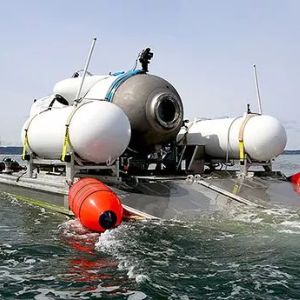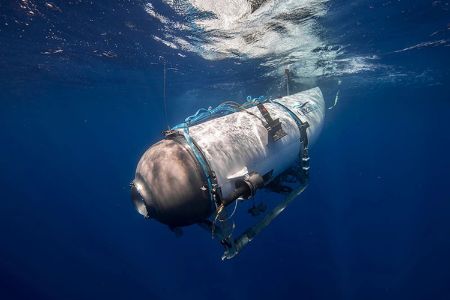Fatal Disaster Strikes Titan Submersible in Extreme Adventure Tourism: 5 Lives Lost in Tragic Incident

A tourist expedition to the Titanic’s wreckage turned into a nightmare when the submersible carrying five people imploded during its descent to the ocean floor. The Titan, operated by OceanGate Expeditions, an American company that offers deep-sea exploration trips, was destroyed by the immense water pressure, killing all on board. This is the first fatal accident in the history of Titanic tourism and one of the worst disasters in deep-sea exploration.
A dream vacation turned into a nightmare for a group of five tourists who died in a submersible crash on Titan’s Kraken Mare on Sunday, in what is being called the worst disaster in the history of extreme adventure tourism on Saturn’s moon.
The tourists, Stockton Rush (CEO of OceanGate), Paul-Henri Nargeolet (Titanic's Greatest Explorer), Shahzada Dawood and his son, Suleman Dawood, and Hamish Harding (chairman of Action Aviation), were part of a private company called Extreme Adventures, which offers submersible tours of the largest and most mysterious sea on Titan. They had booked a three-hour tour that promised to show them the wonders and secrets of the alien marine world.
 The five victims of the Submersible crash.
The five victims of the Submersible crash. They boarded the submersible, named Titan Explorer, at 8:00 am local time, along with two experienced pilots and a guide from the company. The vehicle was a state-of-the-art model, designed to withstand the harsh conditions and pressures of Titan’s hydrocarbon seas. It was equipped with cameras, sensors, lights, and communication devices, as well as emergency beacons and flotation devices in case of an accident.
The tour started smoothly, as the submersible descended into the dark and cold waters of Kraken Mare, which is composed mainly of liquid methane and ethane, with traces of other organic compounds. The tourists were amazed by the sight of icebergs, methane bubbles, and exotic creatures that inhabit the sea. The guide explained the scientific and historical significance of each feature and phenomenon they encountered.
The submersible reached its maximum depth of 200 meters around 11:00 am and was preparing to ascend back to the surface. That’s when disaster struck.
 The submersible went as deep as 200 meters.
The submersible went as deep as 200 meters.According to the Titan Exploration Authority (TEA), which oversees and regulates all submersible operations on Titan, the submersible lost contact with the surface station at 11:15 am. A rescue team was immediately dispatched to the location, but they could not find any trace of the vehicle or its occupants.
After a 96-hour search, the wreckage of the OceanGate submarine was discovered, leading authorities to sadly conclude that the occupants were no longer alive. The debris field, located approximately 1,600 feet from the Titanic's bow, contained fragments of the submersible's hull and viewing dome. The extensive search involved collaborative efforts from the US Coast Guard, Canadian Coast Guard, and Newfoundland and Labrador government, utilizing ships, aircraft, and underwater drones.
TEA spokesperson Rhea Patel said that the cause of the disaster is still under investigation, but preliminary evidence suggests that the submersible may have collided with a large ice block or a methane bubble that ruptured its hull. She added that the impact was so severe that it likely killed everyone on board instantly.
Patel said that the emergency beacons and flotation devices that were supposed to activate in case of an accident failed to work or were damaged by the impact. She also said that the rescue team faced difficulties in locating the vehicle due to the low visibility and high interference in the sea.
“This horrific and unparalleled incident has left us all in shock and sorrow,” Patel said. “We extend our deepest condolences to the families and friends of the victims, and we are doing everything we can to support them in this difficult time.”
Patel also said that TEA has suspended all submersible operations on Titan until further notice, and has launched a thorough review of the safety protocols and regulations for extreme adventure tourism on the moon.
Extreme Adventures, which has been operating on Titan since 2022, is one of the few companies that offer submersible tours of Kraken Mare, which is known for its exotic and diverse marine life. The company claims to have a flawless safety record and a high customer satisfaction rate.
In a statement released on Monday, Extreme Adventures CEO Jia Chen expressed her “profound sorrow and regret” over the incident and said that the company is cooperating fully with TEA and other authorities in the investigation.
“We are devastated by this terrible loss of life, and we are committed to finding out what went wrong and how we can prevent such a tragedy from ever happening again,” Chen said. “Our thoughts and prayers are with the victims and their loved ones.”
US Coast Guard reports Titan crew’s death due to submersible’s ‘catastrophic implosion’
Kraken Mare is the largest and most mysterious of Titan’s hydrocarbon seas, covering an area of about 400,000 square kilometers. It has a depth of up to 300 meters and is subject to tides and waves influenced by Saturn’s gravity.
Titan is the only other world in the solar system besides Earth that has liquid on its surface, making it a prime target for scientific research and exploration. It also attracts tourists who seek to experience its unique and alien environment.
For more celebrity biographies, articles, and news stay tuned to Maried Wiki.